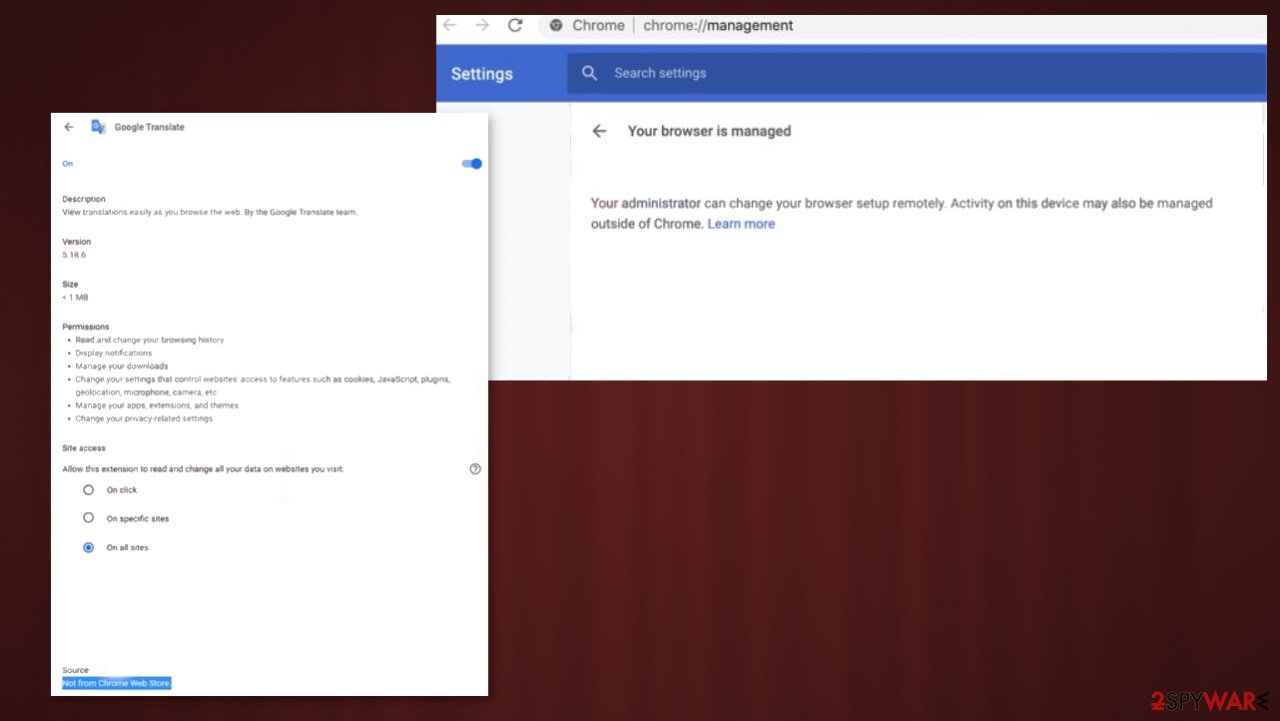Google Translate scam (Easy Removal Guide) - Chrome, Firefox, IE, Edge
Google Translate scam Removal Guide
What is Google Translate scam?
Google Translate scam – a potentially unwanted program that has nothing to do with Google Inc.

Google Translate scam is a malevolent browser extension that is developed to alter browser settings that enables it to redirect users to third-party portals with suspicious, explicit, and questionable content. This browser plug-in might also show deceptive ads and impede the overall performance of any device. It is related to unknown third-parties that can lead to various unwanted changes and activities on the machine.
Furthermore, the fake Google Translate extension adds the “Managed by your organization” feature to Chrome browsers. This option doesn't allow users to restore any of the modified browser settings. This intruder could end up on your device when you're installing software from a bundle or by believing a deceptive ad.
Due to its functions and distribution, a fake Google Translate add-on is categorized as a potentially unwanted program (PUP). Since it has nothing in common with the legitimate Google service, this PUP should be immediately removed. You can easily do that with our free instructions below.
| name | Google Translate scam |
|---|---|
| Type | Redirect virus, a browser plug-in, PUP |
| distribution | Official browser web stores, deceptive ads, fake installers, software bundles |
| imitated service | Google Translate |
| Symptoms | Redirects to suspicious, promotional portals, pop-up ads, slower performance, slower internet speed, altered browser settings |
| Risks | Installation of PUPs or malware through redirects to third-party sites, privacy and security issues |
| Additional info | “Managed by your organization” pop-up shows up when trying to revert the changed browser settings |
| Removal | Eliminate PUPs causing redirects with dependable anti-malware software |
| System fix | Use the FortectIntego system repair tool to restore system values back to normal and remove tracking cookies and other browser-related data |
Browser hijackers usually appoint a website of their choice as the new tab and the homepage. So every time an infected browser is launched, the promotional site opens up. In addition, it changes the default search engine, so every time users type something in the URL bar, they're immediately redirected.
Typically, users don't end up on a legitimate search engine right away. They are redirected through a set of shady websites. That allows PUPs, like Google Translate fake extension to gain revenue by sharing various browsing-related data collected from the users, including:
- most visited sites,
- clicked ads,
- IP addresses,
- device and browser details,
- geolocations,
- search inquiries, etc.
Furthermore, scam Google Translate can cause redirects to suspicious sites. These redirects can happen when you push any links. And lastly, this PUP could show ads as recommended search results. The promoted sites might be malicious as the junkware operators don't care where the money comes from as far as it does.

Therefore, if you thought that fake Google Translate plugin was a legitimate service and it's now impeding your browsing experience, you can't restore the changed browser settings due to the “Managed by your organization” error – it's time to get rid of it once and for all.
To remove Google Translate scam from your device, you must have a reliable anti-malware tool. We suggest using either SpyHunter 5Combo Cleaner or Malwarebytes to accomplish this task with a push of a button. In addition, these apps might prevent PUPs and malware from gaining access to your devices.
The feature that prevents restoring altered browser settings can be fixed with the “Managed by your organization” solution. Once that's done and Google Translate scam removal is completed, launch your system repair tool. Experts[1] recommend using the FortectIntego tool for this task as it's capable of restoring corrupted system files and cleaning up your machine.
Watch out for potentially unwanted programs when installing apps from bundles
PUP developers use various deceptions to trick users into installing their creations. One scheme involves deceptive ads claiming that this software will improve your privacy and security while browsing the internet. Another one doesn't even require direct user consent to be installed as it installs the PUP with software or freeware bundle.

One research showed[2] that 62% of the 50 most downloaded apps from a popular software vendor were actually software bundles with PUPs. People need to learn how to evade junkware as it only slows down their devices and might pose threats to their privacy.
Therefore, our team has compiled a list of guidelines that, if followed, will keep your device clean:
- After downloading a software pack and launching it – choose Advanced/Custom installation mode instead of the Quick/Recommended/Standard one.
- Go step by step through all offered apps.
- Remove ticks from preselected boxes of programs that you don't trust and don't want to have on your device.
- If some software is unknown, do a quick Google search.
- Opt-in for the installation of apps that you trust.
Tutorial for rogue Google Translate extension removal from affected devices
Google Translate virus has no connections to the tech giant. It can only cause privacy and security issues. Trustworthy anti-malware apps recognize its nature and prevent it from installing on devices. VirusTotal report[3] shows that 44 out of 70 AV tools caught this PUP. Here are a few examples of its detection names:
- Win32:Trojan-gen
- Trojan.GenericKD.45672205
- Trojan-Banker.Win32.Passteal.dh
- Malware.AI.3337519304
- Trojan:Win32/SpyAgent!MSR
- TrojanSpy.Keylogger!ItyKXsB5VxE
That reiterates the need for a professional anti-malware tool in every device that's regularly used to browse the internet. With a proper AV tool, you can remove Google Translate scam with ease. Perform a full system scan and eliminate files that the software recommends.
To adequately finish Google Translate scam removal process, you need to check your device for system irregularities and clean up browsing activities. Here's where powerful system repair tools come in handy. If redirects persist, refer to our guides below to recover your browser settings.
You may remove virus damage with a help of FortectIntego. SpyHunter 5Combo Cleaner and Malwarebytes are recommended to detect potentially unwanted programs and viruses with all their files and registry entries that are related to them.
Getting rid of Google Translate scam. Follow these steps
Uninstall from Windows
Instructions for Windows 10/8 machines:
- Enter Control Panel into Windows search box and hit Enter or click on the search result.
- Under Programs, select Uninstall a program.

- From the list, find the entry of the suspicious program.
- Right-click on the application and select Uninstall.
- If User Account Control shows up, click Yes.
- Wait till uninstallation process is complete and click OK.

If you are Windows 7/XP user, proceed with the following instructions:
- Click on Windows Start > Control Panel located on the right pane (if you are Windows XP user, click on Add/Remove Programs).
- In Control Panel, select Programs > Uninstall a program.

- Pick the unwanted application by clicking on it once.
- At the top, click Uninstall/Change.
- In the confirmation prompt, pick Yes.
- Click OK once the removal process is finished.
Delete from macOS
Remove items from Applications folder:
- From the menu bar, select Go > Applications.
- In the Applications folder, look for all related entries.
- Click on the app and drag it to Trash (or right-click and pick Move to Trash)

To fully remove an unwanted app, you need to access Application Support, LaunchAgents, and LaunchDaemons folders and delete relevant files:
- Select Go > Go to Folder.
- Enter /Library/Application Support and click Go or press Enter.
- In the Application Support folder, look for any dubious entries and then delete them.
- Now enter /Library/LaunchAgents and /Library/LaunchDaemons folders the same way and terminate all the related .plist files.

Remove from Microsoft Edge
Delete unwanted extensions from MS Edge:
- Select Menu (three horizontal dots at the top-right of the browser window) and pick Extensions.
- From the list, pick the extension and click on the Gear icon.
- Click on Uninstall at the bottom.

Clear cookies and other browser data:
- Click on the Menu (three horizontal dots at the top-right of the browser window) and select Privacy & security.
- Under Clear browsing data, pick Choose what to clear.
- Select everything (apart from passwords, although you might want to include Media licenses as well, if applicable) and click on Clear.

Restore new tab and homepage settings:
- Click the menu icon and choose Settings.
- Then find On startup section.
- Click Disable if you found any suspicious domain.
Reset MS Edge if the above steps did not work:
- Press on Ctrl + Shift + Esc to open Task Manager.
- Click on More details arrow at the bottom of the window.
- Select Details tab.
- Now scroll down and locate every entry with Microsoft Edge name in it. Right-click on each of them and select End Task to stop MS Edge from running.

If this solution failed to help you, you need to use an advanced Edge reset method. Note that you need to backup your data before proceeding.
- Find the following folder on your computer: C:\\Users\\%username%\\AppData\\Local\\Packages\\Microsoft.MicrosoftEdge_8wekyb3d8bbwe.
- Press Ctrl + A on your keyboard to select all folders.
- Right-click on them and pick Delete

- Now right-click on the Start button and pick Windows PowerShell (Admin).
- When the new window opens, copy and paste the following command, and then press Enter:
Get-AppXPackage -AllUsers -Name Microsoft.MicrosoftEdge | Foreach {Add-AppxPackage -DisableDevelopmentMode -Register “$($_.InstallLocation)\\AppXManifest.xml” -Verbose

Instructions for Chromium-based Edge
Delete extensions from MS Edge (Chromium):
- Open Edge and click select Settings > Extensions.
- Delete unwanted extensions by clicking Remove.

Clear cache and site data:
- Click on Menu and go to Settings.
- Select Privacy, search and services.
- Under Clear browsing data, pick Choose what to clear.
- Under Time range, pick All time.
- Select Clear now.

Reset Chromium-based MS Edge:
- Click on Menu and select Settings.
- On the left side, pick Reset settings.
- Select Restore settings to their default values.
- Confirm with Reset.

Remove from Mozilla Firefox (FF)
Remove dangerous extensions:
- Open Mozilla Firefox browser and click on the Menu (three horizontal lines at the top-right of the window).
- Select Add-ons.
- In here, select unwanted plugin and click Remove.

Reset the homepage:
- Click three horizontal lines at the top right corner to open the menu.
- Choose Options.
- Under Home options, enter your preferred site that will open every time you newly open the Mozilla Firefox.
Clear cookies and site data:
- Click Menu and pick Settings.
- Go to Privacy & Security section.
- Scroll down to locate Cookies and Site Data.
- Click on Clear Data…
- Select Cookies and Site Data, as well as Cached Web Content and press Clear.

Reset Mozilla Firefox
If clearing the browser as explained above did not help, reset Mozilla Firefox:
- Open Mozilla Firefox browser and click the Menu.
- Go to Help and then choose Troubleshooting Information.

- Under Give Firefox a tune up section, click on Refresh Firefox…
- Once the pop-up shows up, confirm the action by pressing on Refresh Firefox.

Remove from Google Chrome
Delete malicious extensions from Google Chrome:
- Open Google Chrome, click on the Menu (three vertical dots at the top-right corner) and select More tools > Extensions.
- In the newly opened window, you will see all the installed extensions. Uninstall all the suspicious plugins that might be related to the unwanted program by clicking Remove.

Clear cache and web data from Chrome:
- Click on Menu and pick Settings.
- Under Privacy and security, select Clear browsing data.
- Select Browsing history, Cookies and other site data, as well as Cached images and files.
- Click Clear data.

Change your homepage:
- Click menu and choose Settings.
- Look for a suspicious site in the On startup section.
- Click on Open a specific or set of pages and click on three dots to find the Remove option.
Reset Google Chrome:
If the previous methods did not help you, reset Google Chrome to eliminate all the unwanted components:
- Click on Menu and select Settings.
- In the Settings, scroll down and click Advanced.
- Scroll down and locate Reset and clean up section.
- Now click Restore settings to their original defaults.
- Confirm with Reset settings.

Delete from Safari
Remove unwanted extensions from Safari:
- Click Safari > Preferences…
- In the new window, pick Extensions.
- Select the unwanted extension and select Uninstall.

Clear cookies and other website data from Safari:
- Click Safari > Clear History…
- From the drop-down menu under Clear, pick all history.
- Confirm with Clear History.

Reset Safari if the above-mentioned steps did not help you:
- Click Safari > Preferences…
- Go to Advanced tab.
- Tick the Show Develop menu in menu bar.
- From the menu bar, click Develop, and then select Empty Caches.

After uninstalling this potentially unwanted program (PUP) and fixing each of your web browsers, we recommend you to scan your PC system with a reputable anti-spyware. This will help you to get rid of Google Translate scam registry traces and will also identify related parasites or possible malware infections on your computer. For that you can use our top-rated malware remover: FortectIntego, SpyHunter 5Combo Cleaner or Malwarebytes.
How to prevent from getting browser plugins
Do not let government spy on you
The government has many issues in regards to tracking users' data and spying on citizens, so you should take this into consideration and learn more about shady information gathering practices. Avoid any unwanted government tracking or spying by going totally anonymous on the internet.
You can choose a different location when you go online and access any material you want without particular content restrictions. You can easily enjoy internet connection without any risks of being hacked by using Private Internet Access VPN.
Control the information that can be accessed by government any other unwanted party and surf online without being spied on. Even if you are not involved in illegal activities or trust your selection of services, platforms, be suspicious for your own security and take precautionary measures by using the VPN service.
Backup files for the later use, in case of the malware attack
Computer users can suffer from data losses due to cyber infections or their own faulty doings. Ransomware can encrypt and hold files hostage, while unforeseen power cuts might cause a loss of important documents. If you have proper up-to-date backups, you can easily recover after such an incident and get back to work. It is also equally important to update backups on a regular basis so that the newest information remains intact – you can set this process to be performed automatically.
When you have the previous version of every important document or project you can avoid frustration and breakdowns. It comes in handy when malware strikes out of nowhere. Use Data Recovery Pro for the data restoration process.
- ^ Viirused. Viirused. Spyware and security news.
- ^ Slade. 62% of the Top 50 Download.com applications bundle toolbars and other PUPs. Emisoft. Security blog.
- ^ VirusTotal. Virustotal. Suspicious file analysis platform.























